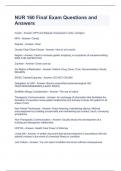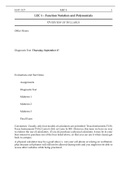Preview 8 out of 60 Flashcards
The benefits of buying summaries with Stuvia:

Guaranteed quality through customer reviews
Stuvia customers have reviewed more than 700,000 summaries. This how you know that you are buying the best documents.

Quick and easy check-out
You can quickly pay through EFT, credit card or Stuvia-credit for the summaries. There is no membership needed.

Focus on what matters
Your fellow students write the study notes themselves, which is why the documents are always reliable and up-to-date. This ensures you quickly get to the core!
Frequently asked questions
What do I get when I buy this document?
You get a PDF, available immediately after your purchase. The purchased document is accessible anytime, anywhere and indefinitely through your profile.
Satisfaction guarantee: how does it work?
Our satisfaction guarantee ensures that you always find a study document that suits you well. You fill out a form, and our customer service team takes care of the rest.
Who am I buying this summary from?
Stuvia is a marketplace, so you are not buying this document from us, but from seller sarahmcarthur. Stuvia facilitates payment to the seller.
Will I be stuck with a subscription?
No, you only buy this summary for $3.36. You're not tied to anything after your purchase.
Can Stuvia be trusted?
4.6 stars on Google & Trustpilot (+1000 reviews)
73356 documents were sold in the last 30 days
Founded in 2010, the go-to place to buy summaries for 15 years now
Recently viewed by you

Exam (elaborations) ·
FF2 Final Exam Latest 2022(Scored 98%)

Summary ·
SOCIOLOGY 212 NOTES

Exam (elaborations) ·
NASM CPT Final Exam Questions With Complete Solutions.

Summary ·
samenvatting organisational behaivour

Exam (elaborations) ·
NUR 160 Final Exam Questions and Answers

Class notes ·
MAT1327/1330 Lecture 1

Exam (elaborations) ·
Abeka Health (9th grade) Test 6 (Final Exam) Actual Questions and Answers 100% Correct

Class notes ·
Microéconomie 2 - Chapitre 3 "La Minimisation Du Profit"

